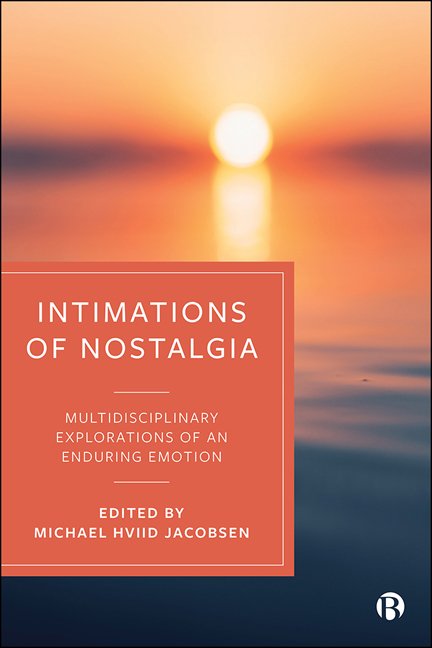Book contents
- Frontmatter
- Contents
- Notes on Contributors
- Preface and Acknowledgements
- Introduction: The Many Different Faces of Nostalgia – Exploring a Multifaceted and Multidisciplinary Emotion
- 1 Philosophy and Nostalgia: ‘Rooting’ within the Nostalgic Condition
- 2 History and Nostalgia: Historicizing a Multifaceted Emotion
- 3 Political Theory and Nostalgia: The Power of the Past in the History of Political Thought
- 4 Sociology and Nostalgia: Micro-, Meso-and Macro-level Dimensions of an Ambiguous Emotion
- 5 Psychology and Nostalgia: Towards a Functional Approach
- 6 Anthropology and Nostalgia: Between Hegemonic and Emancipatory Projections of the Past
- 7 Media Studies and Nostalgia: Media Philosophy and Nostalgizing in Times of Crisis
- 8 Marketing and Nostalgia: Unpacking the Past and Future of Marketing and Consumer Research on Nostalgia
- 9 Literature and Nostalgia: Vestiges of Paradise
- 10 Architecture and Nostalgia: The End of History, the End of the Future and the Prospect of Nostalgia
- Postscript: On Nostalgia of the Future and the Future of Nostalgia – Some Scattered Concluding Observations
- Index
5 - Psychology and Nostalgia: Towards a Functional Approach
Published online by Cambridge University Press: 13 May 2022
- Frontmatter
- Contents
- Notes on Contributors
- Preface and Acknowledgements
- Introduction: The Many Different Faces of Nostalgia – Exploring a Multifaceted and Multidisciplinary Emotion
- 1 Philosophy and Nostalgia: ‘Rooting’ within the Nostalgic Condition
- 2 History and Nostalgia: Historicizing a Multifaceted Emotion
- 3 Political Theory and Nostalgia: The Power of the Past in the History of Political Thought
- 4 Sociology and Nostalgia: Micro-, Meso-and Macro-level Dimensions of an Ambiguous Emotion
- 5 Psychology and Nostalgia: Towards a Functional Approach
- 6 Anthropology and Nostalgia: Between Hegemonic and Emancipatory Projections of the Past
- 7 Media Studies and Nostalgia: Media Philosophy and Nostalgizing in Times of Crisis
- 8 Marketing and Nostalgia: Unpacking the Past and Future of Marketing and Consumer Research on Nostalgia
- 9 Literature and Nostalgia: Vestiges of Paradise
- 10 Architecture and Nostalgia: The End of History, the End of the Future and the Prospect of Nostalgia
- Postscript: On Nostalgia of the Future and the Future of Nostalgia – Some Scattered Concluding Observations
- Index
Summary
Introduction
The word ‘nostalgia’ was first coined by the Swiss physician Johannes Hofer (1688/1934). For Hofer, nostalgia was synonymous with homesickness, and he equated the two in the title of his dissertation, ‘Nostalgia, oder Heimwehe’ (‘Nostalgia, or Homesickness’). For centuries, nostalgia denoted homesickness. As recently as 1943, Willis McCann conducted what, in his words, was the first ‘systematic and controlled investigation’ of nostalgia by comparing ‘one hundred college students who were or who recently had been homesick … with 100 college students who never had been homesick while away from home’ (McCann 1943: 97). Yet, current dictionary definitions reveal that nostalgia and homesickness have acquired distinct meanings. Before we can embark on a journey through the psychological literature, then, we have to identify when nostalgia and homesickness went their separate ways. It appears that their path forked during the post-war years, as by 1954 nostalgia had become a subject of psychological theorizing in its own right, with its now familiar positive connotations. The psychoanalyst Alexander Martin (1954) proposed that nostalgia plays an essential role during recuperation and consolidation phases of development:
I … would rather think of nostalgia as a diastolic phase of the growth rhythm, which is true not only of man, but of nature as a whole. … Always after a phase of rapid development, whether it be scholastic, athletic, artistic, there is what has been referred to as a slump … On this natural return to strength, if not rejected, the individual surges forward to a still higher point of development. (Martin 1954: 103)
By conceptualizing nostalgia as a springboard for growth, Martin foreshadowed recent evidence, to be reviewed later in this chapter, that the emotion is a source of approach-oriented processes, including creativity, inspiration, risk taking and goal pursuit (Sedikides and Wildschut 2016, 2020). In the same year, the social and personality psychologist Gordon Allport (1954) published his influential The Nature of Prejudice. He proposed that nostalgia could play a role in reducing prejudice and forming bonds between individuals from different social groups:
The plan … brings together people of diverse ethnic backgrounds in a ‘neighborhood festival.’ The leader may start discussion by asking some members to tell about his memories of autumn, of holidays, or of food he enjoyed as a child.
- Type
- Chapter
- Information
- Intimations of NostalgiaMultidisciplinary Explorations of an Enduring Emotion, pp. 110 - 128Publisher: Bristol University PressPrint publication year: 2021

